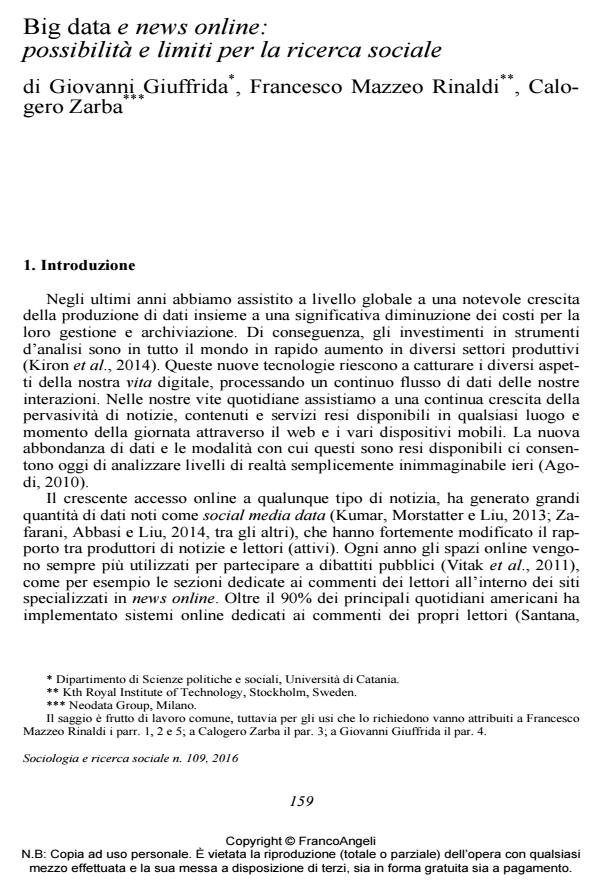Big data e news online: possibilità e limiti per la ricerca sociale
Titolo Rivista SOCIOLOGIA E RICERCA SOCIALE
Autori/Curatori Giovanni Giuffrida, Francesco Mazzeo Rinaldi, Calogero Zarba
Anno di pubblicazione 2016 Fascicolo 2016/109
Lingua Italiano Numero pagine 15 P. 159-173 Dimensione file 70 KB
DOI 10.3280/SR2016-109013
Il DOI è il codice a barre della proprietà intellettuale: per saperne di più
clicca qui
Qui sotto puoi vedere in anteprima la prima pagina di questo articolo.
Se questo articolo ti interessa, lo puoi acquistare (e scaricare in formato pdf) seguendo le facili indicazioni per acquistare il download credit. Acquista Download Credits per scaricare questo Articolo in formato PDF

FrancoAngeli è membro della Publishers International Linking Association, Inc (PILA)associazione indipendente e non profit per facilitare (attraverso i servizi tecnologici implementati da CrossRef.org) l’accesso degli studiosi ai contenuti digitali nelle pubblicazioni professionali e scientifiche
The main aim of this article is to improve knowledge on applicability of Big Data (BD) techniques in social research, by exploring the validity of using BD as an approach in emerging news contexts. In particular, we constructed and examined a large database of historical data of public online comments on a recent constitutional bill review. We using BD technology in order to analyze people’s opinions to this particular reform.
- Editorial: Theories, methods, practices, and fields of digital social research Felice Addeo, Angela Delli Paoli, Gabriella Punziano, in Frontiers in Sociology 1437401/2024
DOI: 10.3389/fsoc.2024.1437401 - Building Decision-making Indicators Through Network Analysis of Big Data Venera Tomaselli, Giovanni Giuffrida, Simona Gozzo, Francesco Mazzeo Rinaldi, in Social Indicators Research /2020 pp.33
DOI: 10.1007/s11205-020-02363-2 - Handbook of Research on Advanced Research Methodologies for a Digital Society Felice Addeo, Valentina D'Auria, pp.24 (ISBN:9781799884736)
- Handbook of Research on Advanced Research Methodologies for a Digital Society Costantino Cipolla, pp.42 (ISBN:9781799884736)
- The Phases of Qualitative and Quantitative Methods in Italian Sociology: Institutionalisation, Social Engagement, and Emerging Problems Giuseppe Masullo, in The American Sociologist /2025 pp.50
DOI: 10.1007/s12108-024-09615-5 - Big Data e Valutazione: una relazione ancora da costruire Francesco Mazzeo Rinaldi, in RIV Rassegna Italiana di Valutazione 68/2018 pp.7
DOI: 10.3280/RIV2017-068002
Giovanni Giuffrida, Francesco Mazzeo Rinaldi, Calogero Zarba, Big data e news online: possibilità e limiti per la ricerca sociale in "SOCIOLOGIA E RICERCA SOCIALE " 109/2016, pp 159-173, DOI: 10.3280/SR2016-109013